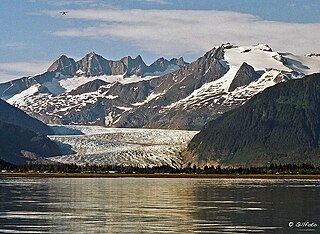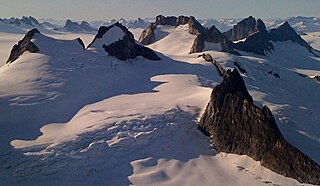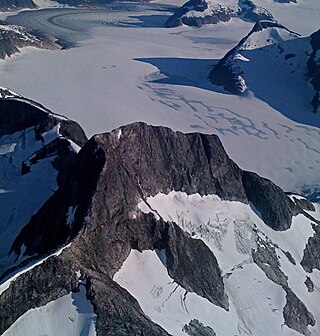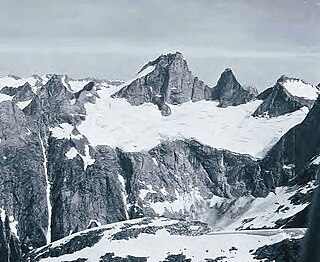Dipyramid is a pair of mountain peaks in Juneau City and Borough, Alaska, United States. It is a part of the Boundary Ranges of the Coast Mountains in western North America. The summit is 34 miles (55 km) north-northeast of the city of Juneau and 1 mile southeast of The Citadel. The peaks are 0.2 miles (322 m) apart.
Mount Nesselrode, also known as Boundary Peak 98, is a 2,474 m (8,117 ft) peak in the Boundary Ranges of the Coast Mountains, located on and in part defining the border between British Columbia, Canada, and Alaska, United States. About 40 miles (64 km) north of Juneau to the west of the lower Stikine River and in the heart of the Stikine Icecap in Juneau Icefield southwest of Atlin Lake, the summit, with a prominence of 924 m (3,031 ft), is also the corner point of Alaska's Haines Borough and Juneau Borough.

Mount Blachnitzky is a 6,552 ft (2,000 m) mountain summit in the city and borough of Juneau, Alaska, United States. It is a part of the Boundary Ranges of the Coast Mountains in western North America. It is located between Gilkey Glacier and Avalanche Canyon; it is named after Klaus Blachnitzky (1921-1988), a surveyor, geodesist, and explorer of the Juneau Icefield. Mr. Blachnitzky was the head surveyor for the Juneau Icefield Research Program. Much of his work was conducted in the vicinity of this summit. In August 1988, having completed almost two seasons instructing student surveyors and scientists in the science and practice of terrestrial field surveying and geodesy, he was killed when he slipped from a rock cleaver on the slope of Vaughan Lewis Glacier. The site of his death is four miles from the mountain named in his honor. In 2004, four climbers made a memorial climb of the previously unclimbed summit, leaving at the peak some surveying mementos of Mr. Blachnitzky's life. That first ascent was made by Scott McGee, Keith Daellenbach, Charles Daellenbach, and Fred Skemp III, on June 30, 2004, via the southwest cirque/south ridge. The mountain's name was officially adopted in 2007 by the U.S. Board on Geographic Names.
Camp 4 Peak is a mountain in the city and borough of Juneau, Alaska, United States. It is a part of the Boundary Ranges of the Coast Mountains in western North America. On the divide between East and West Twin Glaciers, it is located 5 miles north-northwest of Twin Glacier Lake and 27 miles northeast of the city of Juneau.

Mount Wrather is a 5,968-foot (1,819 m) mountain summit located in the Boundary Ranges, in the U.S. state of Alaska. The peak is situated within Tongass National Forest, immediately east of the Mendenhall Glacier, 12 mi (19 km) north of Juneau, Alaska, and 9 mi (14 km) north of Juneau International Airport. Although modest in elevation, relief is significant since the mountain rises up from sea-level at Auke Bay in less than nine miles. The mountain's name was officially adopted in 1968 by the USGS to honor William Embry Wrather (1883–1963), the 6th Director of the United States Geological Survey from 1943 to 1956.

Horn Spire is a 6,700+ ft mountain summit located in the Boundary Ranges of the Coast Mountains, in the U.S. state of Alaska. The peak is situated between the Thiel Glacier and Battle Glacier at the northwest extent of the Juneau Icefield, 31 mi (50 km) north-northwest of Juneau, Alaska, and 12 mi (19 km) east of Lynn Canal, on land managed by Tongass National Forest. Horn Spire is the highest point of the Icefall Spires, and although modest in elevation, relief is significant since the north face of the mountain rises over 4,700 feet above the Thiel Glacier in less than one mile. The peak's descriptive name was submitted in 1965 by Maynard Miller, director of the Juneau Icefield Research Project, and officially adopted that same year by the U.S. Board on Geographic Names. The first ascent of the peak was made June 30, 1973, by Dick Benedict, Gerry Buckley, Craig Lingle, and Bruce Tickell.

The Snow Towers is a 7,100+ ft glaciated mountain summit located in the Boundary Ranges of the Coast Mountains, in the U.S. state of Alaska. The two peaks, 0.1 mi apart, are situated at the apex of the Taku and Herbert Glaciers near the western edge of the Juneau Icefield, 23 mi (37 km) north of Juneau, 1.8 mi (3 km) southwest of Snowpatch Crag, and 6.3 mi (10 km) northeast of Mount Ernest Gruening, on land managed by Tongass National Forest. The mountain was named by members of the Juneau Icefield Research Project in 1964, and was officially adopted in 1965 by the U.S. Board on Geographic Names. The first ascent was made in 1984 by Charles "Dick" Ellsworth and Bruce Tickell.

Emperor Peak is a 6,805 ft (2,070 m) glaciated mountain summit located in the Boundary Ranges of the Coast Mountains, in the U.S. state of Alaska. Emperor Peak is situated in the Taku Range of the Juneau Icefield, 20 mi (32 km) north of Juneau, and 1.2 mi (2 km) south-southwest of Taku Towers, on land managed by Tongass National Forest. The Taku Range is a north–south trending ridge on the edge of the Taku Glacier. This mountain was named in 1964 by members of the Juneau Icefield Research Project, and officially adopted in 1965 by the U.S. Geological Survey.

Princess Peak is a 6,585 ft (2,010 m) glaciated mountain summit located in the Boundary Ranges of the Coast Mountains, in the U.S. state of Alaska. Emperor Peak is situated in the Taku Range of the Juneau Icefield, 18 mi (29 km) north of Juneau, and 1.6 mi (3 km) south of Emperor Peak, on land managed by Tongass National Forest. The Taku Range is a north–south trending ridge on the edge of the Taku Glacier. This mountain was named in 1964 by members of the Juneau Icefield Research Project, and officially adopted in 1965 by the U.S. Board on Geographic Names.

Cathedral Peak is a 6,500+ ft mountain summit located in the Boundary Ranges of the Coast Mountains, in the U.S. state of Alaska. The peak is situated in the Taku Range of the Juneau Icefield, 22 mi (35 km) north of Juneau, and 1 mi (2 km) north of Taku Towers, on land managed by Tongass National Forest. The Taku Range is a north-south trending ridge on the edge of the Taku Glacier. The mountain was named in 1964 by members of the Juneau Icefield Research Project, and officially adopted in 1965 by the U.S. Board on Geographic Names.

Split Thumb is a 5,523 ft (1,680 m) glaciated mountain summit located in the Boundary Ranges of the Coast Mountains, in the U.S. state of Alaska. The peak is situated near the southern periphery of the Juneau Icefield, 9 mi (14 km) northeast of Juneau, 2.15 mi southeast of Nugget Mountain, and 4 mi (6 km) east of Heintzleman Ridge, on land managed by Tongass National Forest. Split Thumb is surrounded by the Lemon Creek Glacier to the west, and Norris Glacier to east. The Split Thumb Icefall is set on the east aspect of the peak. This peak's descriptive name was published in 1951 by the U.S. Geological Survey. The first ascent of Split Thumb was made July 2, 1954, by a Juneau Icefield Research Project party comprising Edward LaChapelle, Dick Hubley, Carlton Ray, Dr. Conrad Buettner, and Bob Goodwin.

Slanting Peak is a 5,200+ ft glaciated mountain summit located in the Boundary Ranges of the Coast Mountains, in the U.S. state of Alaska. The peak is situated in the southern portion of the Juneau Icefield, 18 mi (29 km) northeast of Juneau, and 2.4 mi (4 km) northeast of Guardian Mountain, which is its nearest neighbor. Slanting Peak is surrounded by the North Branch Norris Glacier to its west, and Taku Glacier on the east, and set on land managed by Tongass National Forest. This peak's descriptive name was published in 1960 by the U.S. Geological Survey.

Snowpatch Crag is a 6,345 ft (1,930 m) elevation glaciated mountain summit located in the Boundary Ranges of the Coast Mountains, in the U.S. state of Alaska. Snowpatch Crag is a nunatak surrounded by the Taku Glacier, and is situated near the west side of the Juneau Icefield, 25 mi (40 km) north of Juneau, and 1.8 mi (3 km) northeast of The Snow Towers, on land managed by Tongass National Forest. The mountain was named by members of the Juneau Icefield Research Project in 1964, and was officially adopted in 1965 by the U.S. Board on Geographic Names. Variant names for this geographic feature are "Snowpatch Peak" and "Snowpatch Craig."

Nugget Towers is a mountain ridge with a series of peaks, two primarily, the highest of which is 5,378-ft elevation, and located on the southern periphery of the Juneau Icefield, in the Boundary Ranges of southeast Alaska. These peaks are situated east of Mendenhall Glacier, 10 mi (16 km) north of Juneau, and 1.9 mi (3 km) northeast of Bullard Mountain, on land managed by Tongass National Forest. Stroller White Mountain lies 4.5 mi (7 km) west-northwest on the opposite side of the glacier, and Heintzleman Ridge lies 3 mi (5 km) to the south. Although modest in elevation, relief is significant since the mountain rises 3,500 feet above Nugget Creek's upper basin in less than one mile. Precipitation runoff from the mountain drains into Mendenhall Lake via Nugget Creek and Nugget Falls. This geographic feature's local name was reported in 1965 by U.S. Geological Survey.

The Tusk is a 6,650-foot-elevation (2,027-meter) mountain summit in Alaska, United States.

Dike Mountain is a 6,650-foot (2,027 m) glaciated summit located in the Boundary Ranges of the Coast Mountains, in the U.S. state of Alaska. It is situated 26 miles (42 km) north-northwest of Juneau along the western side of the Juneau Icefield, on land managed by Tongass National Forest. Topographic relief is significant as the summit rises 1,150 feet (350 m) above the Eagle Glacier in 0.4 mi (0.64 km). Neighbors include Mustang Peak 0.8 mi (1.3 km) to the south, and Snowpatch Crag is 3.7 miles (6.0 km) to the east. Dike Mountain was named by members of the Juneau Icefield Research Project in 1964, and the toponym was officially adopted in 1965 by the U.S. Board on Geographic Names.

Mustang Peak is a 6,720-foot-elevation (2,048-meter) glaciated mountain summit located in the Boundary Ranges of the Coast Mountains, in the U.S. state of Alaska. It is situated 25 miles (40 km) north-northwest of Juneau along the western side of the Juneau Icefield, on land managed by Tongass National Forest. Topographic relief is significant as the summit rises 1,200 feet (366 m) above the Eagle Glacier in 0.25 mi (0.40 km). Neighbors include Dike Mountain 0.8 mi (1.3 km) to the north, and The Snow Towers are three miles (4.8 km) to the southeast. Mustang Peak was named by members of the Juneau Icefield Research Project in 1964, and the toponym was officially adopted in 1965 by the U.S. Board on Geographic Names.

Glacier King is a 6,500-foot-elevation (1,981-meter) mountain summit in Alaska, United States.
Mount Ogilvie is a 7,867-foot-elevation (2,398-meter) mountain summit located on, and in part defining, the international border between Alaska, United States, and British Columbia, Canada.















